Australia’s koala population is under threat, having declined by an estimated 26 per cent in NSW alone over the past two decades. But a Sydney university is partnering with one of the world’s largest tech giants to try and reverse the damage, using genome sequencing to help protect koalas from threats such as disease and climate change. Over in South Australia, they’re using drones and facial recognition to help save the koalas.
The University of Sydney and Amazon Web Services are working to create a ‘koala genome library’. This library democratises the research data, allowing the USyd team to work with scientists and conservationists around the world to share research insights, findings and apply solutions faster.
The project, which has backing from both the federal government and the NSW government as part of its goal to double koala numbers by 2050, builds on previous work to sequence the koala genome from back in 2018.
The problem, however, has been in making sense of the data available. Processing and analysing genome data can take years – years that threatened species like koalas simply don’t have. Using the AWS cloud, they can do this heaps faster.
The project is aiming to map the genomes of 450 koalas from across the entire species range and make the data available to researchers anywhere in the world via the AWS Open Data Sponsorship Program. The program covers the cost of storage for datasets of high value to the scientific community and makes it available to be accessed and analysed in the cloud.
[related_content first=”1729902″]
“The best way to safeguard the koala population is generally to stop cutting down their trees” Dr Carolyn Hogg from USyd said.
“But as much as many of us would like to say, ‘let’s just stop doing that’, we have to be realistic. We can’t stop development. We have to find multiple, creative solutions to these problems, and not be wedded to tools we developed in the ‘90s.”
But saving the koalas isn’t just something NSW is doing, the South Australian government is also playing its part.
The state government, Flinders University and conservation charity Koala Life are using drones and facial recognition tech to count, identify, and re-identify our little marsupial friends.
The non-invasive tech will be used as part of a study on koalas at Kangaroo Island and the Adelaide Mount Lofty Ranges to get a better understanding of both their numbers and their movements.
Researchers in Queensland are, meanwhile, using AI-enabled infrared drones to provide more accurate estimates about the number of surviving koalas in bushfire affected areas.
